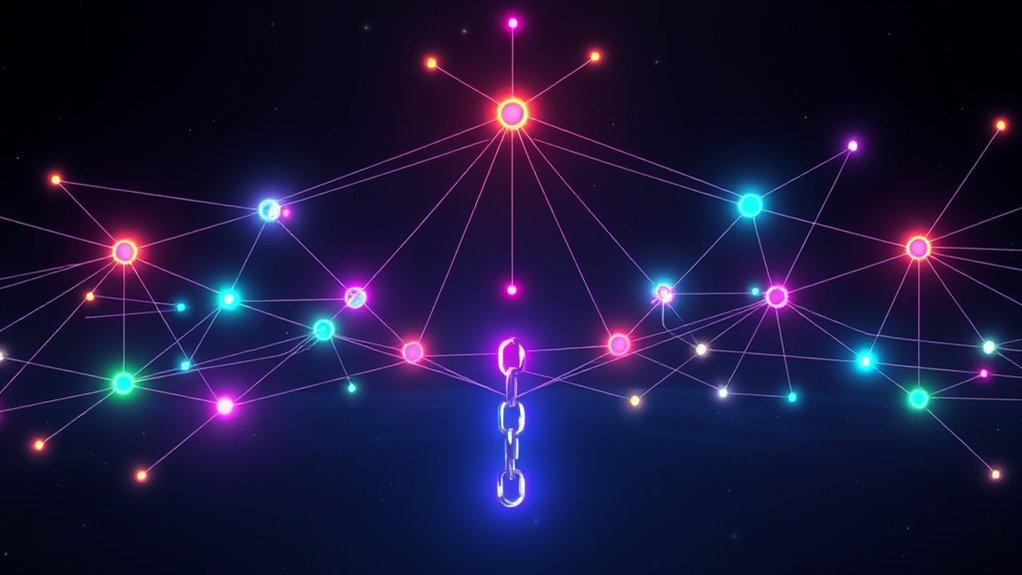Polkadot is a multi-chain blockchain protocol. Think of it as a bridge for different blockchains to chat without drama. Created by Gavin Wood and a team of visionaries, it launched its mainnet in 2020. It juggles security, scalability, and customization like a pro. With its Nominated Proof-of-Stake model, it’s also more energy-efficient than the old-school proof-of-work systems. Want to know how it links up with other blockchains? Stick around.

Polkadot is like the superhero of blockchain protocols, swooping in to save the day with its fancy multi-chain setup. It’s here to interconnect specialized blockchains, making interoperability a reality and scalability a dream come true. Created by Gavin Wood and his gang back in 2016, Polkadot isn’t just a flashy idea—it’s a full-blown protocol with a solid mission.
With its native cryptocurrency, DOT, it operates on a decentralized platform that allows data and assets to transfer like magic, and guess what? No need for a trusted middleman. It’s like a trust fall where everyone actually catches you.
Polkadot’s architecture is slick. The Relay Chain is the backbone, providing security and consensus, while parachains run parallel, each one customizable for unique needs. Efficient scaling solutions are available to accommodate growing projects, and let’s not forget the bridges, linking Polkadot to other blockchains. It’s all about making connections without the awkward small talk. Polkadot’s design is focused on cross-chain interoperability, enabling diverse blockchains to communicate effortlessly. Additionally, its innovative structure aims to support a multi-chain ecosystem, similar to what Polygon offers for Ethereum.
Polkadot’s slick architecture connects customizable parachains with the secure Relay Chain, bridging gaps between blockchains effortlessly.
The protocol aims to tackle the big issues—scalability, security, and interoperability. Talk about ambitious.
In 2017, Polkadot raised over $144 million in an initial coin offering. That’s right, folks—people wanted in on this. Fast forward to 2020, and the mainnet launched with a proof-of-authority model. Later, it switched to a Nominated Proof-of-Stake (NPoS). Sounds fancy, right? It is.
Polkadot is brimming with features. Interoperability is the name of the game, allowing seamless transfers across chains. Scalability? Check. Customizability? You bet. Self-governance? Absolutely.
It’s like a buffet of blockchain benefits. Plus, the energy efficiency of its consensus model is a welcome change compared to those energy-guzzling proof-of-work systems.
Frequently Asked Questions
How Does Polkadot Ensure Security for All Connected Blockchains?
Polkadot’s security game is on point. It uses a shared security model, meaning all those parachains get to ride on the coattails of the Relay Chain’s security.
Validators keep things in check, ensuring every transaction is legit. Plus, if something goes wrong, the whole network rolls back—no one gets left hanging.
Smaller blockchains? They get a boost without having to build their own fortress. It’s a win-win. Trust issues? Not here!
What Programming Languages Can Be Used for Developing on Polkadot?
Developing on Polkadot? Well, get ready for some Rust and WebAssembly action!
These are the big guns in Polkadot’s programming arsenal. Rust brings power and safety, while WebAssembly enables smart contracts to strut their stuff.
Fancy flexibility? The Substrate framework has got you covered, letting developers whip up custom blockchains like it’s a piece of cake.
Can Polkadot Be Integrated With Existing Blockchain Networks?
Absolutely, Polkadot can play nice with existing blockchain networks.
It’s got this cool multi-chain setup that lets different blockchains chat and work together. Parachains act like specialized sidekicks, while bridges connect to heavyweights like Ethereum and Bitcoin.
This isn’t just for show—it boosts security and makes life easier for developers.
So, if you’re worried about your blockchain being a lone wolf, relax. Polkadot’s got it covered.
Integration? Totally possible.
How Does Polkadot Handle Governance Decisions Among Its Users?
Polkadot’s governance? It’s like a chaotic democracy on steroids.
DOT token holders plunge into decision-making, while the Council and Technical Committee keep things running. Proposals need friends—seriously, they require seconding.
Spamming? Not on their watch. Staking tokens is a must to even toss a proposal into the mix.
Oh, and don’t forget the supermajority vote; it’s not just a suggestion. Flexibility and community power? That’s the name of the game.
What Are the Main Advantages of Using Polkadot Over Other Blockchains?
Polkadot’s got some serious perks.
Interoperability? Check. Different blockchains chatting like old friends.
Scalability? Oh yeah, transactions flying in parallel.
Governance? A decentralized dream where users actually have a say.
Security? New blockchains get a safety net without the hassle of setting up their own guards.
It’s like a club where everyone’s welcome, and the rules are flexible.
Frankly, it’s a no-brainer for developers tired of the same old limitations.





